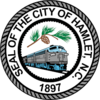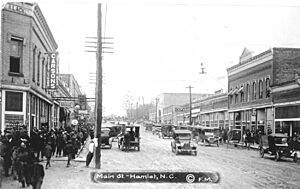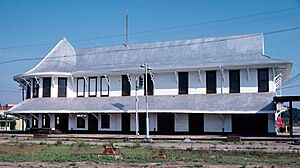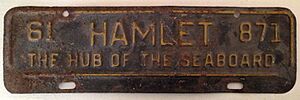Hamlet, North Carolina facts for kids
Quick facts for kids
Hamlet, North Carolina
|
|||
|---|---|---|---|

Clockwise from top left: Bank of Hamlet, Main Street, mural of Hamlet native John Coltrane on Vance Street, Hamlet Depot.
|
|||
|
|||
| Country | United States | ||
| State | North Carolina | ||
| County | Richmond | ||
| Settled | 1869 | ||
| Incorporated | February 9, 1897 | ||
| Area | |||
| • Total | 5.35 sq mi (13.87 km2) | ||
| • Land | 5.27 sq mi (13.64 km2) | ||
| • Water | 0.09 sq mi (0.22 km2) | ||
| Elevation | 404 ft (123 m) | ||
| Population
(2020)
|
|||
| • Total | 6,025 | ||
| • Density | 1,143.91/sq mi (441.65/km2) | ||
| Time zone | UTC-5 (Eastern (EST)) | ||
| • Summer (DST) | UTC-4 (EDT) | ||
| ZIP code |
28345
|
||
| Area codes | 910, 472 | ||
| FIPS code | 37-29160 | ||
| GNIS feature ID | 2403787 | ||
Hamlet is a city located in Richmond County, North Carolina, in the United States. In 2020, about 6,042 people lived there.
Contents
History of Hamlet
The area where Hamlet is now was first known as Sandhills. In 1866, a railroad line was built through this area. The very first house was built here in 1869.
In 1872, a man named John Shortridge bought the land. He was from England and wanted to build a textile factory. The next year, he renamed the area Hamlet. He likely named it after small villages, also called hamlets, in the British Isles. To celebrate, he planted a sycamore tree that stood until 1946.
A post office opened in 1876. That same year, Shortridge sold land to another railroad company. This company finished its line through Hamlet by 1877. More railway buildings were constructed in 1894. Hamlet officially became a town on February 9, 1897.
The Seaboard Air Line Railroad decided to make Hamlet its main hub in the region. Because of this, Hamlet grew very quickly. By 1910, the town had many stores and even a Coca-Cola bottling plant. The population grew from 639 people in 1900 to over 4,000 by 1930. The first hospital in the county opened in Hamlet in 1915. By 1940, it was the largest hospital in the area.
Hamlet's Railroad Growth
Seaboard Railroad helped Hamlet grow a lot by investing in the town. By the end of World War I, 30 trains passed through Hamlet every day. The company built maintenance shops, a roundhouse (for turning trains), and a shipping yard.
After World War II, a large, modern train yard was built north of town. It opened in 1954 and was the first of its kind in the Southeastern United States. Seaboard trains mostly carried goods, but they also brought tourists. Famous passenger trains like the Orange Blossom Special and the Silver Meteor stopped in Hamlet.
Many train passengers would stay in Hamlet at hotels like the Terminal Hotel or Seaboard Hotel. This brought business to Main Street, which had banks, shops, and even an opera house. Famous people like Booker T. Washington and Franklin D. Roosevelt visited Hamlet.
Seaboard Railroad offered good jobs to many people in Hamlet. These jobs had good pay and benefits. This helped Hamlet develop a strong middle class. This was different from nearby Rockingham, where many people worked in textile mills for lower wages.
Changes and Challenges
Starting in the 1960s, Hamlet's economy faced challenges. More people started using roads, trucks, and airplanes instead of trains. Seaboard Railroad merged with other companies and moved some jobs out of Hamlet. They also reduced passenger train services, meaning fewer visitors came to town. Seaboard became CSX Transportation in 1986.
In the 1970s, large stores like K-Mart and Walmart opened in Rockingham. This drew shoppers away from Hamlet's local businesses. Many traditional shops on Main Street started to close. The Coca-Cola bottling plant closed in 1973.
By the late 1980s and early 1990s, many buildings on Main Street were empty. The Hamlet Depot only had a few Amtrak passenger trains stopping each day. The decline in manufacturing, like textiles, also affected the whole Richmond County area.
Between 1980 and 1990, Hamlet grew by adding surrounding land and about 1,200 new residents. In 1982, Richmond Community College started the Seaboard Festival. This event celebrates Hamlet's railroad history with local vendors, races, and music. It became an annual tradition.
In 1990, parts of the movie Billy Bathgate were filmed on Main Street. In June of that year, Hamlet received the All-America City Award. This award recognized the city's efforts to improve its library, save its hospital, and host the Seaboard Festival.
The Imperial Food Products Fire
On September 3, 1991, a fire happened at the Imperial Food Products plant in Hamlet. Many exits at the plant were locked, which was against fire safety rules. The fire injured 54 people and sadly caused the deaths of 25 people (24 workers and 1 delivery driver). This event brought negative national attention to the town.
After the fire, state officials gave the company a very large fine for the safety violations. The town spent about $13 million to clean up the plant site and help the economy recover. They focused on highlighting Hamlet's railroad history and renovating the Hamlet Depot.
Geography of Hamlet
Hamlet covers a total area of about 5.14 square miles (13.3 km2). Most of this area, about 5.05 sq mi (13.1 km2), is land. The rest, about 0.09 sq mi (0.23 km2), is water. In the 1930s, a dam was built in the city. This created the Hamlet City Lake, which is about 50 acres in size.
Population of Hamlet
| Historical population | |||
|---|---|---|---|
| Census | Pop. | %± | |
| 1900 | 639 | — | |
| 1910 | 2,173 | 240.1% | |
| 1920 | 3,808 | 75.2% | |
| 1930 | 4,801 | 26.1% | |
| 1940 | 5,111 | 6.5% | |
| 1950 | 5,061 | −1.0% | |
| 1960 | 4,460 | −11.9% | |
| 1970 | 4,627 | 3.7% | |
| 1980 | 4,720 | 2.0% | |
| 1990 | 6,196 | 31.3% | |
| 2000 | 6,018 | −2.9% | |
| 2010 | 6,495 | 7.9% | |
| 2020 | 6,042 | −7.0% | |
| 2021 (est.) | 6,022 | −7.3% | |
| U.S. Decennial Census | |||
2020 Census Information
As of the 2020 United States census, there were 6,042 people living in Hamlet. These people lived in 2,462 households, which included 1,407 families.
Education in Hamlet
Hamlet used to have its own school system. But in 1968, it became part of the Richmond County School System.
The town has several schools for younger students:
- Fairview Heights Elementary School
- Monroe Avenue Elementary School
- Hamlet Middle School
- Richmond County Ninth Grade Academy
Older students attend Richmond Senior High School, which is just west of the city.
Richmond Community College is also located in Hamlet. It was started in 1964 and serves students from Richmond and Scotland counties. The college has a large campus and offers associate degrees.
More About Hamlet
Hamlet is a very important spot for three major CSX railroad lines.
- One line goes north towards Raleigh, North Carolina and south towards Savannah, Georgia.
- Another line goes east towards Wilmington and west towards Bostic. This line splits near Monroe, North Carolina. One part goes northwest to Charlotte, and the other continues west towards Atlanta, Georgia.
- The third line branches off the second one just east of Hamlet and goes towards Charleston, South Carolina.
Because of all these train lines, Hamlet is known as a great place for people who enjoy watching trains.
The National Railroad Museum and Hall of Fame is also located in Hamlet.
Hamlet was once the biggest city in Richmond County. However, its neighbor, Rockingham, has now grown larger. In the early 1900s, more than 30 trains stopped in Hamlet every day. They were traveling to big cities like New York City, New Orleans, and cities in Florida.
Hamlet was known as "The Hub of the Seaboard." It had seven hotels and many places for travelers to stay and eat. Miranda Chavis, who manages the railroad museum, said, "Hamlet was like the Charlotte airport is today."
Besides the Hamlet Passenger Station, the Main Street Commercial Historic District is also a special historical place. It is listed on the National Register of Historic Places.
Notable People from Hamlet
Many talented people have come from Hamlet, North Carolina:
- Frederick C. Branch: The first African-American officer in the United States Marine Corps.
- Louis Breeden: A former football player who played as a defensive back for the Cincinnati Bengals.
- John Coltrane: A world-famous jazz saxophonist and composer. He received a Grammy Lifetime Achievement Award.
- Dannell Ellerbe: A football player who won the Super Bowl twice with the Baltimore Ravens and Philadelphia Eagles.
- Wayne Goodwin: A politician who served in the North Carolina state government.
- Melvin Ingram: A football player who plays as a linebacker for the Miami Dolphins.
- Ashton Locklear: A two-time gold medalist in women's artistic gymnastics for the uneven bars. She was also a World Champion in 2014.
- Mike Quick: A former football player who was a wide receiver for the Philadelphia Eagles.
- Tom Wicker: A former chief and columnist for The New York Times in Washington.
- Perry Williams: A former football player who played as a cornerback for the New York Giants.
See also
 In Spanish: Hamlet (Carolina del Norte) para niños
In Spanish: Hamlet (Carolina del Norte) para niños







